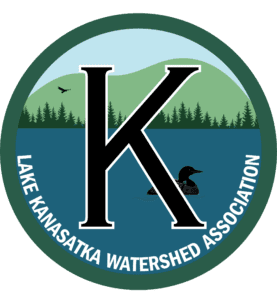Overview
There are some basic principles of eco-friendly gardening that apply to all gardening situations, whether on a shorefront or elsewhere. Here are links to two brief articles that summarize the main points.
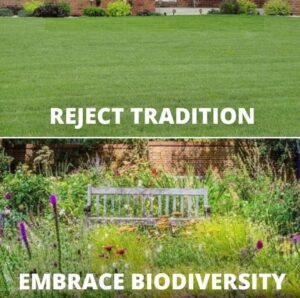
Photo Credit: Nature’s Neighbours: King’s Head Hethersett
Reduce or Eliminate the Lawn
Lake Kanasatka evolved with forested shorelines, which we humans have altered over the centuries through agriculture, logging, housing, recreational development and poor land-use practices. The more we can promote natural habitats, the better off the lake will be. And lakes like less lawn!
Lawns act like an impervious or paved surface. The shallow roots of cultivated turf grass do little to absorb rain or to hold soil in place to prevent erosion. Lawns provide no habitat and very little benefit to wildlife or pollinators. They also require huge amounts of time, attention, money, and gasoline for mowing and blowing.
You may still want an area of lawn for recreation, or for the area over your leach field. If you do choose to have a lawn:
- Minimize the size to only what is absolutely needed, especially nearer to the water
- Maintain vegetative buffers between the lawn and the lake to help capture stormwater runoff
- Reduce or eliminate fertilizer, especially if you leave grass cuttings in place. And by NH State law, no fertilizer use, even organic fertilizer, is allowed within 25 feet of the water!
- Set the mower blade on the highest setting to increase the lawn’s ability to absorb water
- Consider lawn alternatives using native groundcovers and short perennials.
Additional Links: - Lakes Like Less Lawn—Maine Lakes and Portland ME Water District
- Natural Lawns Fact Sheet—New Hampshire Lakes
- NHPR Have You Considered Rewilding Your Lawn?
- Have you ever questioned why you spend so much time mowing, raking, maybe even watering your lawn? We consider how lawns have become an intrinsic part of the American dream, what “re-wilding” your lawn might do for pollinators and the planet, and what you might plant instead. Sam Evans-Brown of NHPR’s Outside/In is guest host. Airdate: Tuesday, August 11, 2020
- Lawn Care Within the Protected Shoreline—NHDES
- Please Don’t Fertilize Our Lakes!—NHDES
- Lawn Basics—The Perfect Earth Project
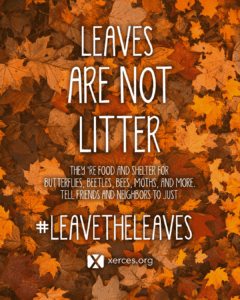
Leaves are not Litter. Credit: Xerces Society.
Leave the Leaves, Stems and Snags
In the fight to keep our lake clean, bare ground is the enemy. Leaves form natural mulch that helps suppress weeds and fertilize the soil. Why spend money on mulch and fertilizer when you can make your own?
One of the best things we can do for the health of Lake Kanasatka is to NOT do so much fall cleanup. To the extent possible, leave leaves where they fall. If you must rake a lawn or pathway, collect the leaves and spread a light layer under plants, in the woods, or wherever you have bare ground. Just don’t pile them too deep in areas where you want plants to grow because too much of a good thing can create a no-grow zone.
The National Wildlife Federation tells us that removing leaves eliminates wildlife habitat. Animals like turtles and toads, songbirds, mammals and invertebrates rely on leaf litter for food, shelter and nesting material. Many moth and butterfly caterpillars overwinter in fallen leaves before emerging in spring.
Over time these leaves, as they decay, will provide mulch, add nutrients to your soil, and make your yard more spongy and better able to absorb rain and runoff. You’ll help pollinators too. And save alot of effort on fall yard work!
Similarly, if you are growing perennials, leave the stems intact through the winter. The stem cavities provide important nesting habitat for a variety of insects. And birds will continue to harvest seeds from the dried flowerheads through the winter. You can grow your own birdfeeders!
Encouraging birds is a key way to keep insect populations in balance. To keep birds coming to your yard in the winter, leave a brush pile in your yard. Birds like environments that are a little more on the wild side, and small piles of branches and leaves will attract ground-dwelling invertebrates (bugs!)—perfect food for birds like American robins and northern flickers. The habitat piles also provide shelter for species like the Carolina wren. Decomposing branches will replenish nutrients to your soil.
Standing dead trees, or snags, also provide important habitat. Snags are favored foraging and nesting places for about 35 species of birds in the Northeast. Insectivorous birds such as woodpeckers and nuthatches depend heavily on snags as a source of food. These birds, in addition to being an integral part of our natural ecosystem, are very beneficial in helping to control unwanted insect pests.
Snags should be at least three inches in diameter at breast height and at least six feet tall. If you need to cut down a tree, consider leaving a snag, as tall as would be safe if it were to fall down, rather than cutting the tree all the way to the ground. Dead trees have a positive impact on the environment nearly as much as living trees.
Here are some links to more information about leave the leaves, stems and snags:
- Nesting and Overwintering Habitat for Pollinators and Other Beneficial Insects—The Xerces Society
- Leaving Leaves and Flower Stalks for Wildlife—University of New Hampshire Extension
- Fallen Leaves are Everything—The Humane Gardener
- Experts Give You Permission to Stop Raking Your Leaves this Fall (PBS News Hour)
- Ask the Expert: Doug Tallamy Explains Why (and How to) Leave the Leaves
- Dead Trees Bring Life to the Forest: The Value of Snags for Healthy Forest Ecosystems—Yakima Valley Audubon Society
- Something Wild: Life After Death in NH Forests—NHPR Audio Recording
- Wildlife Habitat Improvement: Woodlands and Wildlife—University of New Hampshire Extension
- Life After Death: Dead Wood is Not Really Dead—The Humane Gardener
- These Animals are Made Possible by Fallen Leaves—The Humane Gardener
- The Stump Tour—The Humane Gardener
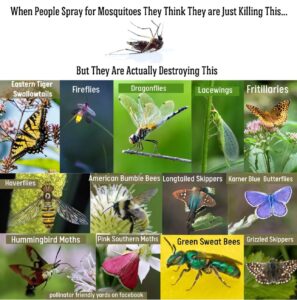
Photo Credit: Save Our Pollinators Page, Pollinator Friendly Landscaping Facebook Group
Skip the Fertilizers, Herbicides and Pesticides
In traditional gardening, we battle the arrival of insects and animals and treat them as pests that are eating our plants. In native plant gardening we welcome their arrival and indeed encourage them (the exception would be non-native insect invaders that do not have any local predators). Yes, insects or deer may eat our plants, but they are almost always kept in check by other actors in the food web. If you have abundant plantings in your yard, there should be enough for all!
Many people think that using organic fertilizer is OK, but even organic fertilizer adds phosphorus and nitrogen to the soil, and if these elements run into the lake they can be detrimental to water quality and can support cyanobacteria blooms. The better approach is to plant native plants, which rarely or never need fertilizing. And eliminate or reduce the lawn, which takes heavy doses of fertilizer to be maintained, and replace it with native groundcovers.
Using herbicides may be the easiest way to eliminate unwanted plants, but they are dangerous to the user and to the environment. Wherever possible, consider non-chemical methods of removing plants like smothering them under a layer of cardboard or tarps, or digging out plants by their roots.
The effects of pesticides on human health are well known. Knowing this, why would you put any insecticide into the environment, or hire companies that apply them for you? If you spray for mosquitoes, please understand that you are killing ALL the insects that come in contact with the spray, not just the mosquitoes. The same is true for ticks. Investigate ways to use plants and mulched areas to reduce mosquitoes and ticks without harming other insects, or humans, or water quality.
Here are some links to more information about fertilizers, herbicides and pesticides:
- Pesticide Myths Every Gardener Should Know—The Xerces Society for Invertebrate Conservation
- Supporting Ecologically Sound Mosquito Management—The Xerces Society for Invertebrate Conservation
- Say “No” to Both Mosquitoes and Mosquito Control Companies—Audubon Society of Northern Virginia
- How to Set Up a Mosquito Larva Trap—Audubon Society of Northern Virginia
- Mosquito Dunks FAQ
- Lakewise Information Sheet—Ticks and Shorelands—Vermont Department of Environmental Conservation, Watershed Management Division
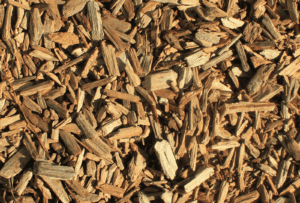
Textures and Patterns of Wood Chips, 1/5/13. Credit: Yinan Chen
Add Layers, Mulch and “Soft Landings”
Many yards have large trees, but the terrain under them is almost devoid of smaller plants. It is important to include as many vegetative layers as possible throughout your property: overstory and understory trees, understory shrubs and vines, herbaceous (non-woody) plants including perennials, grasses, and both woody and herbaceous groundcovers, ferns and mosses, and a diverse soil layer that includes leaf litter, germinating seedlings, and soil organic material. No matter how much your property is covered in vegetation, there are probably areas where the understory plants could be beefed up.
Bare ground is the enemy, as it is the most likely to allow runoff and erosion. Make your property into a giant sponge. While native plantings are the best at doing this, if you have bare areas, make sure they are at least mulched. You can purchase bagged mulch from local nurseries or have bulk mulch delivered, but it can be expensive. Arborist wood chips can usually be found for free and they make great mulch. The Moultonborough Public Works Department (68 Highway Garage Drive off Moultonborough Neck Road) usually has a large pile of wood chips just outside the gate that are free for the taking. And arborists doing tree work on your property or in your neighborhood will gladly dump wood chips in your yard to save themselves a trip to the dump.
“Soft landings” is simply a concept to help you position where you create your spongy areas. The spots beneath large trees, out to their drip edges, are particularly important for providing areas with understory plants, leaves left in place, and mulch. This environment provides the soft areas where insects can burrow, overwinter, and pupate. Encouraging this activity fuels the bio-cycle of supporting insects, pollinators, birds and other wildlife.
Here are some links to more information about layers, mulch, and soft landings:
- Erosion Control Mix Fact Sheet—NH Lakes
- Using Arborist Wood Chips as a Landscape Mulch—Washington State University Extension
- Grounded and surrounded–How you can help wild animals come in for a soft landing—The Humane Society of the United States
- Soft Landings—Heather Holm
- Sponge Landscapes–Absorbing rain water back into the earth with native vegetation—Maine Organic Farmers and Gardeners
Work with Your Landscape Contractors
Many of us do our own yard work, but some of us hire landscape contractors to do the work for us. Either way, we are responsible for making sure we or the people we hire do this work in lake-friendly ways like not using fertilizer and pesticides, reducing or eliminating lawns, not blowing leaves into the lake (or better yet, not using leaf blowers at all), leaving the leaves, and planting native plants where possible. We can’t assume that the people we hire know what best practices are and many of the workers do not have much or any training.
Here are some links to more information about working with landscape contractors:
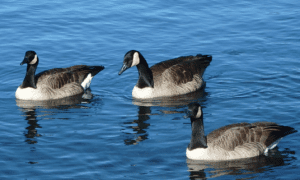
Branta canadensis (Canada goose), 2/23/20. Credit: Donna Fernstrom, Richmond, Virginia.
Manage the Geese!
Resident Canada geese populations in North America are estimated at 4 million. We certainly know they have found Lake Kanasatka! When their numbers grow, they can become a nuisance. They can be aggressive, cause unsanitary conditions, and destroy property at a rapid rate. Their numbers have grown at an incredible pace over the last few decades and they are becoming a widespread problem.
Adult Canada geese can live more than 20 years and they mate every year, usually at the same location. Their young generally return to their birthplace to reproduce as well. If, for example, four geese from every clutch survive to be mating adults, it does not take complicated mathematics to see how exponential population growth occurs. Controlling nesting habits is much less costly than controlling already large populations.
A goose couple needs to feel safe from predators before it will be comfortable building a nest. While there is no silver bullet to discourage geese, there are a few approaches that can be effective. Geese are highly intelligent and adaptive, so it is incredibly difficult to fool them for a long time. And to really expel them, you may need a professional management company or state agency to help out.
The most effective and natural goose repellant is establishing a tall, dense vegetated buffer along the shore. This cannot be a little strip of scraggly vegetation. To be really effective, a goose buffer must be at least 3 feet tall by two feet wide. But overall effective shoreline management calls for even wider buffers anyway. So a good buffer will serve the lake AND convince the geese to go elsewhere.
In addition, grass is the preferred food for geese so if you have a lawn, it will attract them. Aside from having a buffer, the next best way to deter geese is to not have the lawns they like to graze on.
Here are some links to more information about deterring geese:
Good Housekeeping Tips
Beyond gardening, all of the activities that occur in our yards can have an impact on the Lake. We need to follow best practices for maintaining septic systems, caring for our yards in a “green” manner, reducing impervious areas like driveways and walkways where possible, maintaining and washing cars and boats, salting and sanding roads and driveways, disposing of pet waste, and handling hazardous waste safely.
